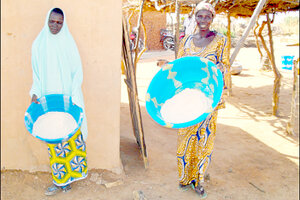Threshing mills make life less of a grind for West African women
Women farmers in West Africa are replacing manual pestle and mortars with grinding machines that save time and grueling labor.

A grinding machine halves the time and labor needed to thresh grain into flour for these women in Niger.
Courtesy of ICRISAT
The majority of women in developing countries rely on agriculture, and it is widely acknowledged that gender should be a major consideration in agricultural development for the rural poor.
When we think of how to improve the situation for women farmers, we often focus on farming issues such as land rights, training, and access to better seeds and markets. But for many women, post-harvest chores entail a heavy work burden that needs to be relieved to improve their lives. Doing so could also improve their communities’ resilience to drier climates.
The pestle and mortar are still the main tools used to grind staple cereals such as millet and sorghum in most sub-Saharan countries. But manually grinding grains is painful and time-consuming for rural women with relentless daily workloads in West Africa.
The International Crops Research Institute for the Semi-Arid Tropics (ICRISAT) and its partners have been working with women to try progressive technologies to ease their work burden. As part of the HOPE Project, funded by the Bill and Melinda Gates Foundation, women farmers like Zénabou Halilou from Niger are replacing manual pestle and mortars with grinding machines that save time and labor.
"Before the mill was installed in our village, we manually processed all our grain,” says Halilou. “Threshing, husking, and milling used to take about 16 hours of my daily time. Thanks to the mill I save nearly eight hours a day. This has made a big difference.
“I can now spend more time on food processing and have just started a poultry farm. I also have more time for my children. Instead of meals served very late or not at all, they now eat every night before going to bed,” she explains.
The time needed to prepare and process grain is a key criterion for smallholder farmers in choosing their crop. Saving several hours a day in millet preparation encourages farmers to grow this drought-tolerant crop. So introducing this post-harvest technology helps farmers become more resilient to drier climates.
Under the CODEWA project funded by the German Ministry for Economic Cooperation and Development, ICRISAT explored crop diversification strategies to help farmers in the Sahel region boost their resilience to drought. This includes encouraging them to grow highly drought-resistant traditional crops, such as fonio, the smallest millet and a major staple cereal crop in dryland regions of West Africa.
Very nutritious and fast growing – it just needs six to eight weeks from sowing to harvest – the grain is used to prepare porridge, couscous, bread, and beverages. But its tiny size (2,000 grains per gram) means women commonly spent hours threshing the grain.
Over the past decades, farmers have adopted other cereal crops that are easier to process, such as maize. But maize yields suffer in dry weather, leaving drought-affected farmers at risk of losing their harvest when water is scarce.
The dissemination of an award-winning fonio threshing machine that can prepare 2 kilograms (4.4 pounds) of grain in six minutes instead of two hours of hand pounding has been a driver to reintroduce the cultivation of this hardy cereal.
The World Bank, through its West Africa Agricultural Productivity Program Project, has recently funded the distribution and assessment of fonio-husking machines in Senegal. This is good news as fonio is often the only crop farmers succeed in harvesting in very dry climates.
Technologies that free women from manual threshing are also appreciated for other reasons. Halilou proudly shows off her hands.
“Threshing and husking used to make my hands very rough,” she says. “Now that I use the mill, they are much smoother, and I am not ashamed to greet people with my hands.”
• This article originally appeared at AlertNet, a humanitarian news site operated by the Thomson Reuters Foundation.

